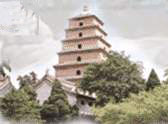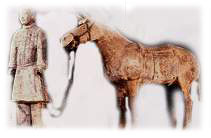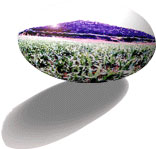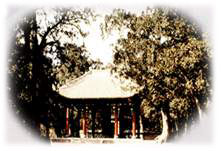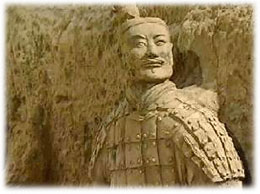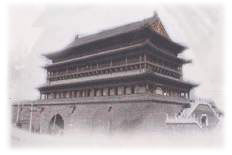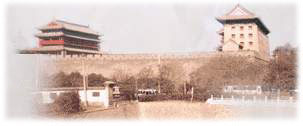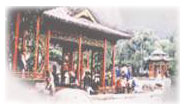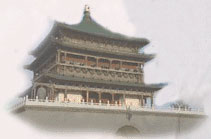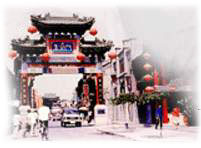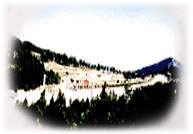Great Wild Goose Pagoda Xi'an
At all times, Great Wild Goose Pagoda id regarded as the masterpiece excelling the Nature. Since Monk Xuanzang fetched the sutra, the legend has been told all over the capital.
Great Wild Goose Pagoda spires loftily in the Daci'en Temple. The temple is in the south su burb of Xi'an, the ancient capital. After Rabbi Xuanzang, the heir arch of the Tang Dynasty, fetched the sutra from India, where Buddhism originated, having experienced a lot of adversity and dangers, the emperor of the Tang Dynasty welcomed him ceremoniously, and let him preside in the newly built Daci'en Temple. |
|
In 652 A.D. (the 3rd year of Yonghui Period), Rabbi Xuanzang presented a memorial to the emperor to build the grand Dayan Tower for storing up the sutra. It's the sanctum for Rabbi Xuanzang to translate and explain the sutra of Buddhism, also the place where Number One Scholars, Jinshi and Juren of the past dynasties superscripted, and where longhairs and artists wrote poems and drew pictures. Poets of the Tang Dynasty, such as Dufu, Censen, baijuyi etc., all stepped on the tower and expressed their feelings, leaving countless peaks of the poetic perfection, especially the supernatural tales like "Xi You Ji" (means a westward joumey) for the later generations to appreciate.
Mounting the grand Dayan Tower, looking into the distance while leaning on the handrail, you can see the whole ancient city of too many beautiful things, which makes you relaxed, happy and reluctant to leave.
Welcome to Great Wild Goose Pagoda and Xi'an, the ancient city.
Tomb Figures of Cavalry of the Qin Dynasty Xi'an
|
In China, the earliest pottery tomb figures appeared in the Period of the Warring States, but then, it was rough and relatively small with short duration. On the contrary, the tomb figures of soldiers and horses of the Qin Dynasty are craftworks of relatively high level because they are not only high and big, but also finely made and nicely sculpted. The pottery tomb figures are 1.78 meters high at the lowest, |
and 1.97 meters at the highest. All the pottery tomb figures in the delves are holding weapons they used in the actual combat, facing the east, showing that Emperor Qin never forgot to perish the 6 kingdoms and achieved his ambition of unifying the world.
Small Wild Goose Pagoda Xi'an
The Small Wild Goose Pagoda is situated in Jianfu Temple in the south of the Xi'an City. Jianfu Temple is a famous Buddhism temple in the Chang'an city of the Tang Dynasty. The royalty built it in 684 (the first year of the Tang Ruizong Wenming Era) to "Bless" (Xianfu) Gaozong Lizhi after his death. It was originally named Xianfu Temple, and renamed as Jianfu Temple by Wu Zetian in 690 (the first year of Wu Zetian Tianshou Era).Rabbi Yijing of Buddhism ever translated lection and made his theory here after he fetched sutra from India by sea.He left us a great amount of sutra books. |
|
The Small Wild Goose Pagoda is the model of the close eave brick towers in the early period. It was built between 707 and 709 (the Tang Zhongzong Jinglong Era), originally with 15 floors. But it's now only 43.3 meters high because the top of the tower had been destroyed in the great earthquake in Shaanxi in 1556. The tower is like a plane square, the whole figure tall and straight and beautiful. Arc doors were made with blue stone from south to north under the tower. On its lintel and frame creep red flower grains and the map of sustentation of God and Man (Tian ren gong yang tu) were carved finely, which is the artistic pith of the stone inscription of the Tang Dynasty.
"Yanta Tower Morning Bell", the 8000 kilogram iron bell made in 1192 (the 3rd year of the Jin Mingchang Era), is 3.55 meters high, its edge diameter is 2.5 meter. Since the Qing Kangxi Era, it has been regarded as one of "Guan zhong ba jing" (the 8 sights inside the pass) for the melody of the bell sound because the monks in the temple beat the bell according not only to the correct time, but also to the tune.
In the Small Wild Goose Pagoda, there are still more than 10 ancient kiosks, platforms, buildings, pavilions halls and houses. Arranged symmetrically and regularly, they are magnificent and solemn. In the garden, there are shading greenery, and old trees on both sides of the path. The compound is very sequestered with exhibition rooms all over of rich culture, among which "Folklore Room" shows in mass the ancient rich colorful folklore culture and popular industrial arts all over Shaanxi Province (also called Shaanxi Sanqin Dadi). You must be relaxed, happy and reluctant to leave after you see it.
The Tomb of Emperor Qinshihuang Xi'an
|
Emperor Qinshihuang (259-210B.C.), Yingzheng, founded the first feudal empire in Chinese history after annexing the 6 Kingdoms of Qi, Chu, Yan, Han, Zhao and Wei in 221B.C. He began to have his tomb that took 38 years built once he came into power, levying more than 700 thousand culprits. The tomb is in the east of the Lintong County. It is 35 kilometers from the Xi'an city. As surveyed, it hasn't been robbed off. As recorded in "Shiji" (Record of the History), there were water and silver in the tomb to represent all the rivers and seas. With the development of the technology, especially the archeological technology, the palace and the treasury under the earth of the tomb will see the light again. |
The Huangdi Tomb Xi'an
Related as the cemetery of Xuanyuan Huangdi, the ancestor of the Chinese people, Huangdi Tomb is situated on the top of Mount Qiao north of county seat of Huangling. Huangdi was a great chieftain at the end of the Chinese primeval period, also the ancestor to create the civilization of the Chinese people. He used jade as his weapon, and made boats, vehicles, |
|
bows and arrows. His wife, Luozu, could raise silkworms, and his history official, Cangji, created characters his subject, Danao, created the Ganzhi calendar, and his music official, Linglun, made music instruments. Huangdi was also recorded in the history books for punishing the evil and unifying the Chinese people for the first time.
Museum of Emperor Qinshihuang's Tomb Figures of Soldiers and Horses Xi'an
|
In March 1974, villagers of the Xiyang Village, while welling, found by chance the delves of Emperor Qinshihuang's Tomb Figures made up of Soldiers and Horses that were buried in the Yanzhai Village Lintong County. They named them respectively No.1 Delve, No.2 Delve and No.3 Delve according to the time when they were founded. The total acreage of delves is 22,780 square meters.In the No.1 Delve, there are 210 tomb figures in military suits, arrayed as in the actual combat. In the No.2 Delve, |
more than 100 pottery tomb figures are unearthed, and more than 500 horses and carriages are found. And in the No.3 Delve, there are only 4 horses and 1 carriage and 568 pottery tomb figures. Finely made and nicely sculpted, Qinshihuang's tomb figures are high and big, and they're artworks of relatively high level. Implements ever used in the actual combat numbered in 10 thousands are exhibited in the delves. All kinds of them were finely made, and they're transcendental artworks. The Museum of Emperor Qinshihuang's Tomb Figures of Soldiers and Horses are one of the 10 most famous places in China, and are announced as the world cultural heritage by UNESCO.
The Drum Tower Xi'an
The Drum Tower is on the northern side of the western street in the city. It was built in 1380 (the 13th year of Ming Hongwu Era), and were rebuilt in 1699 (the 38th year of the Qing Kangxi Era) and in 1740 (the 5th year of the Qing Qianlong Era). It's named as the Drum Tower because of the big drum placed on the tower, which was hit at dusk everyday for giving the correct time. |
|
The Drum Tower is altogether 33 meters high, 52.6 meters wide, covering more than 1970 square meters. The midmost hollow are gate from the south to the north is both 6 meters in the height and width, and it's 38 meters long from the south to the north, and 52 meters from the east to the west. The Drum Tower is a two-floor tower, and its structure is straight up like a pole, with double eaves and Xieshan roof. The tower is clear in arrangement because its outside eaves and flat base are all decorated with blue green hoppers. The Drum Tower is of abundant vitality and of grandiosity as the completion of the Bell Drum Tower Square gives more prominence to its scene. In the new Ding Chou spring, happiness could be felt directly as the newly produced great drum was placed in the Drum Tower. Made of and covered by only one piece of high quality ox hide, the big drum is 1.80 meters high, and its diameter is 2.83 meters. Its weight is 1.5 tons, and the stomach diameter is 3.43 meters. The number of the nails on it is 1996 symbolizing the year 1996, and with the added 4 copper rings, the total number is 2000 which symbolizes the year 2000, thus urging us to win our way and go to the 21st century. The new drum sounds sonorous and heavy, and can be heard 10 Li away if it is beat heavily. And this drum has been recorded in the Guinness Book of Records.
The Xi'an Circumvallation Xi'an
|
Built between 1370 to 1378 (the Hongwu Era of the Ming Dynasty), more than 600 years ago from now, the Xi'an circumvallation of the Ming Dynasty is the most completely reserved site of ancient circumvallation in our country. |
Its perimeter is 13.7 kilometers with earthen cities on each gate of the city, on which city towers and arrow towers were built.
The west gate is regarded as the jumping off point of the Silk Road, and in its earthen city, there is a big sweet water well excavating in the Kangxi Era, on which all people of the Xi'an city lived before they began to use the tap water. In order to let the visitors know more about the history of the Xi'an city, "Exhibition of the History of the Development of the Xi'an City" is held chronically inside the city tower. It shows people the historic flux of Xi'an of more than 3000 years with large numbers of pictures and characters. In addition, temporary exhibitions are held a periodically. "Zhong jun lei gu tai" (the platform for beating the military drum) was built beside the city tower, including a big drum, and exhibitions of all types of archaized instruments for defending the city.
"The Archaized Welcoming Ceremony to the Ancient City" is held inside the earthen city of the north gate. When the visitors enter the city, ranks of dagger holding knights in armatures will welcome them, light holding ladies-in-waiting will blaze a way, the civilian will present the gold key of the city and the customs declaration form. The visitors can enjoy the elegant manners of the culture of more than 1000 years ago by hearing the beautiful ancient music. The form of the ceremony is of very large scale, thus attracting thousands of guests from China and foreign countries.
City towers and arrow towers at the east gate have been repaired and are appearing new, and will be officially open by the end of this year.
The Huaqing Pond Xi'an
The Huaqing Pond is situated at the foot of Mount Li, almost 35 kilometers eastward from Xi'an City. As recorded, "Ligong" (Palace of Li) was ever built here in Xizhou. I
n 747 A.D., Tang Xuanzong ordered to build palace around the mountain, and to build cities around the palace. Huaqing Place was perished during "Anshizhiluan" (The Rebel of An Lushan and Shi Siming). In the Qing Dynasty, Huaqing Pond was rebuilt and based on that, today's Huaqing Pond appeared after constant construction, covering 85560 square meters. In 1982, |
|
the site of the bathes of the emperor of the Tang Dynasty in Huaqing Palace was found by accident, and among them there was "Haitang bath" (Haitang is the name of a flower), also called "Guifei Pond" (Guifei means the high-ranked imperial concubine) which Tang Xuanzong built for his favorite wife, Yang Yuhuan. On the Xixiu Mountain of Mount Li, the site of Fenghuotai (the platform for ignition to tell military intelligence) of Xizhou can be seen vaguely.
The Bell Tower Xi'an
The Bell Tower is situated in the center of the Xi'an City. It was built in 1384 (the 17th year of the Ming Hongwu Era) originally at the end of today's Guanji Street, and was moved to the current position in 1582 (the 10th year of the Ming Wanli Era). It was ever rebuilt in 1740 (the 5th year of the Qing Qianlong Era). In the past time, the copper bell was hung in the tower to give the correct time at dawn, so it's named as the Bell Tower.
|
Made of blue bricks, the base platform looks like a square, 8.6 meters high and 35.5 meters wide, and covers more than 1370 square meters. Its height altogether is 36 meters from the ground to the top of the tower. It's a magnificent construction rich in national style of classic elegance and beauty. It's totally made of bricks and wood covered with deep green colored glaze tile, |
eaves and rooms overlapping, each of the four corners has 4 peaks, hoppers, Zaojing (also decorations), woodcarving and colored drawing are decorated at each floor. The whole city will appear before your eyes if you climb the tower and look into the distance.
The new bell in the ancient city Xi'an resembles the Jingyun Bell of the Tang Dynasty, and was beat at dawn in the new Ding Chou spring, and from then this sight have reappeared in the ancient city. The original Jingyun Bell of the Tang Dynasty is now the state level cultural relic, it's the most famous bronze bell in existence. Its timbre is purely beautiful, and of delicate workmanship, and it was floridly decorated and inscribed by Tang Ruizong. Originally, it was hung in the tower to tell the correct time. In order to use the cultural resource fully, the Bureau of the Xi'an Cultural Relic made a bell resembling the Jingyun Bell. Its total height is 2.45 meters, weight 6.5 tons, and the outside diameter of the bell skirt is 1.65 meters. Besides the sculpt, grain decoration and inscription of the new one are all the same as those of the old.
Shuyuanmen Xi'an
The ancient cultural street of Shuyuanmen is situated in the south of the old district of the city. 106 meters or so away from the south circumvallation of the Ming Dynasty, its total length is 570 meters. Shuyuanmen is famous for situating Guanzhongshuyuan, the biggest institute of the Ming Dynasty in Shaanxi. Most of the constructions in the whole street of Shuyuanmen have walls built with blue bricks, doors and windows built with grilles, |
|
and sloping roofs. Full of firms and integrating all functions of culture, tourism and commerce, this street is well-off, tidy and of a neat touch.
The Qian Tomb Xi'an
|
The Qian Tomb was the tomb where Gaozong Lizhi (628-663A.D.), the third emperor of the Tang Dynasty, and Wu Zetian (624-704A.D.), the only woman emperor in Chinese history, were buried together. It's on the Mount Liang, 6 kilometers north of the Qian county, and 80 kilometers away from the Xi'an City. It was built in 684 A.D., and took 23 years. |
It not only had a magnificent appearance, but also stored many things. As recorded in "Sushengjibei", when Tang Gaozong was dying, his last words were to bury in tomb all the drawings and pictures he loved, so there were all kinds of things in the tomb. |
